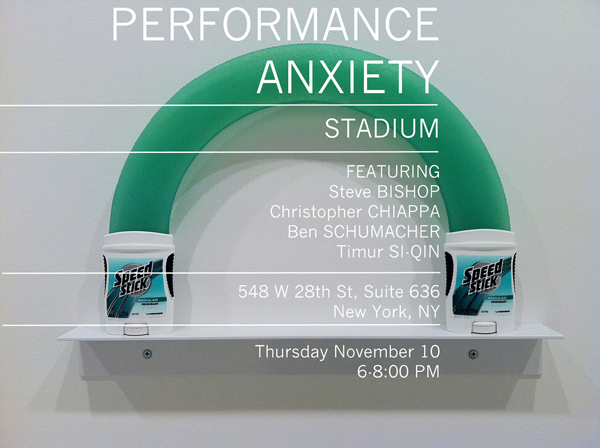Lafayette Anticipation associate curator Anna Colin talks to artist Tyler Coburn about Ergonomic Futures, a speculative project engaged with art, design, science, anthropology and writing. In this interview, Coburn discusses the research, production process and network of collaborators of a multilayered project ultimately concerned with the futures of humankind. Anna Colin: When one comes across your museum seats Ergonomic Futures (2016—) in contemporary art exhibitions—and soon in natural history, fine art, and anthropology museums—they look… [read more »]
“One of the best looking, conceptually cohesive exhibitions I’ve ever been to in Chelsea.”

Performance Anxiety
Curated by Nicolas Djandji
Stadium, 548 W 28th St, Suite 636
10 November – 20 December, 2011
Opening: Thursday, November 10th • 6:00pm – 8:00pm
Stadium is pleased to announce its inaugural exhibition, Performance Anxiety, curated by Nicolas Djandji. Featuring the work of Steve Bishop, Chris Chiappa, Ben Schumacher, and Timur Si-Qin, the exhibition will run from November 10th until December 20th, 2011.
Employing mass-produced products designed for bodily self-improvement, the artists in Performance Anxiety explore contemporary manifestations of consumer culture. Here, the notion that the pursuit of athletic, hygienic, and professional perfection should be sought through the constant purchase of new products is cast into doubt. Through a series of works arresting these normally utilitarian, performance-enhancing products in sculpture, Performance Anxiety waxes upon the paradoxical, collectively shared desire of the present-day individual to become superhuman–physically fit, sexually attractive, and immaculately groomed—by way of altering the body’s chemistry and obscuring its most basic functions. Contextualizing these items as aesthetic elements rather than functional goods, each artist carves a meditative space reflecting upon the absurd modus operandi of these products.
Drawing on the legacy of Minimalist sculpture, the included artists point to both art historical cues—for instance, the removal of the artist’s hand and the introduction of quotidian materials into the realm of high art—but also, in reversal, how the Minimalist aesthetic has come to factor into marketing consumer goods, specifically communicating measures of taste and sophistication. Speaking simultaneously to the degeneration of Minimalism’s once-radical content through its subsumption as a marketing tool, Performance Anxiety unearths our hesitance to critically consider our own relationships to both these types of items and to our oft-impenetrable, unconscious relationships to advertising, to which no one is alien.










































































